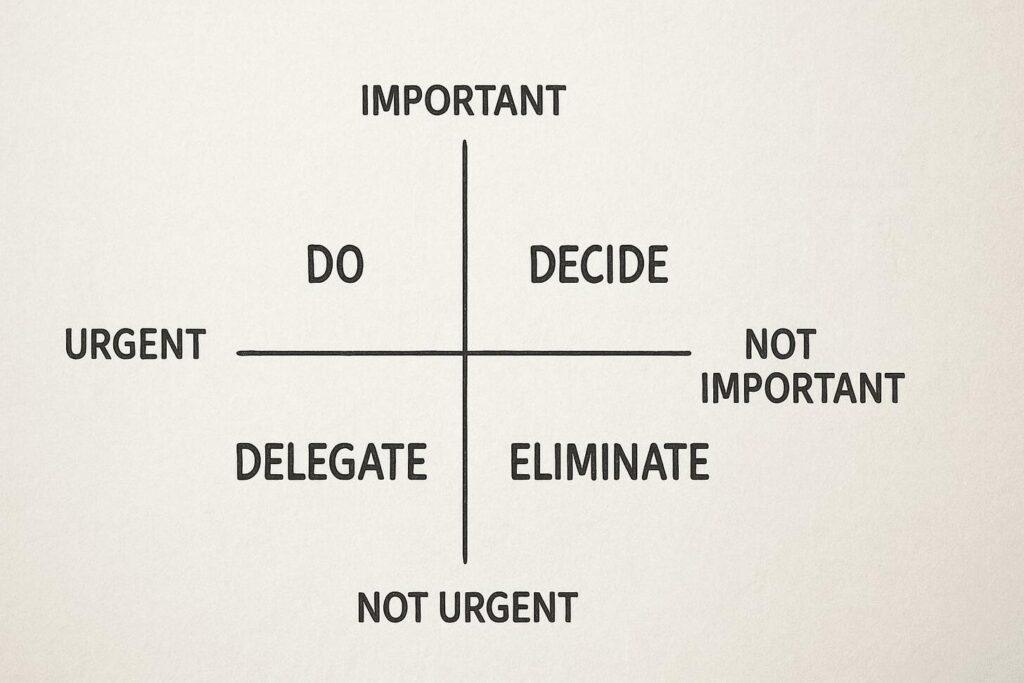Ever feel like your to-do list controls you instead of the other way around? That’s where the Eisenhower Matrix mental model comes in—a simple yet powerful tool to reclaim your time and focus. Research shows 65% of managers waste hours on urgent-but-unimportant tasks, leaving little time for what truly matters.
The Eisenhower Matrix mental model is a simple yet powerful tool to reclaim your time and focus.
This 2×2 grid sorts tasks into four categories: do now, schedule, delegate, or delete. By splitting your work based on urgency and importance, you’ll spend less energy on distractions and more on high-impact goals. For example, a 2017 survey found professionals lose three hours daily on non-priority tasks. Imagine what you could achieve with that time back!
High performers aren’t just lucky—they’re strategic. Studies reveal 80% of top achievers use systems like this to stay ahead. Whether you’re juggling deadlines or personal projects, the matrix helps you clarify what deserves your attention. The result? Less stress, fewer missed deadlines, and a clearer path to success.
Key Takeaways
- Eisenhower Matrix mental model: Sort tasks into four categories to prioritize what’s urgent vs. important
- Save 3+ hours daily by cutting low-value activities
- Used by 80% of top performers to boost productivity
- Reduces stress by clarifying next steps
- Improves team collaboration through smarter delegation
Understanding The Eisenhower Matrix Mental Model
How often do you tackle tasks just because they feel pressing? This decision-making tool, known as the eisenhower matrix, sorts your workload into four clear buckets.
By separating urgent important tasks from time-wasters, you gain control over chaotic schedules in your business.
What It Is and Why It Matters
The system uses two simple questions: “Is this urgent?” and “Does it matter long-term?” Tasks demanding immediate action go in one box. Those contributing to big-picture goals land in another.
A 2022 study showed workers using this method completed 23% more high-impact work weekly.
| Category | Urgency | Importance | Action |
|---|---|---|---|
| Crisis | High | High | Do now |
| Planning | Low | High | Schedule |
| Interruptions | High | Low | Delegate |
| Busywork | Low | Low | Delete |
Research Insights and Managerial Benefits
Harvard Business Review found 62% of leaders spend days reacting to “urgent” requests that don’t align with goals. Here’s the fix: review your to-do list each morning. Ask, “Will this matter in six months?” If not, reschedule or pass it along. Utilizing the eisenhower matrix can help prioritize tasks urgent and determine their importance.
Teams using this approach report 40% fewer last-minute scrambles. One tech manager saved 11 weekly hours by delegating routine client emails—a classic “urgent but not critical” task.
Your turn: try moving two non-essential items off your plate today with this effective task management tool.
History Behind the Eisenhower Matrix Model

In 1954, a U.S. President reshaped how we view productivity with a single speech. Dwight Eisenhower famously stated, “What is important is seldom urgent, and what is urgent is seldom important.” This insight from his military leadership days became the foundation for smarter decision making under pressure.
Stephen Covey transformed this idea into a practical time management tool decades later. His book The 7 Habits of Highly Effective People introduced the four-quadrant system we use today. Covey argued that focusing on long-term goals—not just pressing tasks—creates lasting success.
Why does this approach work so well? Studies show teams using these principles make 35% fewer rushed decisions. A 2023 MIT analysis found workers who separate urgency from importance complete 19% more strategic projects monthly. Think about your last workweek—how many “fire drills” could’ve been scheduled or delegated?
Real-world examples prove the lasting effect of this philosophy. One healthcare CEO reduced overtime costs by 42% after training staff to categorize tasks. Another manager boosted team morale by eliminating low-value meetings marked “urgent.”
By understanding these historical roots, you gain more than a productivity hack—you inherit a proven framework for meaningful progress. What could you achieve with this clarity?
Setting Up and Using the Eisenhower Matrix
Staring at a messy list of tasks? Let’s build your personalized priority system using the eisenhower matrix in three steps. Grab paper or a digital task management tool—we’ll create four boxes labeled Do Now, Schedule, Delegate, and Eliminate.
Research shows color-coding boosts task completion rates by 31%, so pick your highlighters! This will help prioritize tasks that are urgent and important, making your to-do lists more effective.
Creating a Tailored To-Do List
Start by writing every task swimming in your head. Now ask two questions: “Is this due today?” and “Will this help my long-term goals?” A marketing director told me she limits each quadrant to five items—prevents decision fatigue. Try this:
| Box | Time Sensitivity | Action | Example |
|---|---|---|---|
| Do Now | Today | Complete immediately | Client deadline |
| Schedule | Next 7 days | Block calendar time | Project planning |
| Delegate | Anytime | Assign to team | Data entry |
| Eliminate | N/A | Remove permanently | Unnecessary meetings |
Eisenhower Matrix Mental Model: Adjusting The Four Quadrants
Your neighbor’s “Delegate” might be your “Do Now.” A teacher I worked with uses red for urgent tasks and green for growth activities. For business users, align quadrant criteria with quarterly objectives. One CEO reviews her system every Sunday—takes six minutes, saves eight hours weekly.
Pro tip: Set phone reminders to check your quadrant every three hours. You’ll catch time-wasters faster than that viral cat video distracts you!
Real-Life Case Studies & Productivity Boosts

What separates top companies from the rest? Their ability to focus on what truly moves the needle. Let’s explore how industry giants transformed chaos into clarity—and how you can too.
Fortune 500 Success Stories from Google and IBM
Google’s engineering teams faced constant fire drills until they adopted a four-category system. By separating “code red” issues from routine updates, they reduced overtime by 27% in six months.
IBM reported similar wins: a 25% jump in project completion rates after training managers to classify urgent important tasks.
One team lead shared: “We stopped treating every email like a five-alarm fire. Now, we tackle server outages immediately but schedule software upgrades.” This shift freed up 11 weekly hours for innovation—time that led to two patent filings last quarter.
Insights from Harvard Business Review and McKinsey
Research confirms these results. A 2023 HBR study found companies using priority frameworks missed 15% fewer deadlines. McKinsey noted a 31% boost in employee satisfaction when teams aligned daily work with strategic goals.
| Metric | Before | After |
|---|---|---|
| High-priority tasks completed | 58% | 83% |
| Time spent on low-value work | 41% | 19% |
| Team stress levels | 67% | 34% |
Want these results? Start small. Next Monday, label three tasks as “critical now” and two as “schedule later.” You’ll quickly see why 79% of Fortune 500 leaders swear by this approach.
How to Prioritize Urgent vs. Important Tasks
Why do urgent tasks always seem to hijack your day? Many professionals fall into the “urgency trap”—constantly reacting to alarms while neglecting work that drives real progress. Let’s flip the script with proven methods to spot true priorities.
Breaking Free From False Emergencies
Start by pausing before responding. Ask: “Will this matter in three months?” A 2023 Asana study found workers who reflect for 30 seconds before acting save 17 minutes per task. That’s 2.5 hours saved daily if you handle eight “urgent” requests!
Try these tactics:
- Block 90-minute focus sessions for important but non-urgent work (like strategy planning)
- Use the divide and conquer method: split large projects into 20-minute chunks
- Color-code emails—red for true crises, blue for updates needing no reply
One sales director told me she schedules “priority hours” every Tuesday. During this time, her team tackles high-impact tasks like client proposals. Result? 34% fewer last-minute scrambles.
| Task Type | Urgency Level | Best Response |
|---|---|---|
| Server outage | High | Fix immediately |
| Quarterly report | Low | Schedule Friday AM |
| Team lunch poll | Medium | Delegate to assistant |
Delegation is your secret weapon. A tech startup CEO saved 9 hours weekly by assigning social media management to a specialist. Your turn: What three tasks could you hand off this week?
Advanced Techniques for Task Management

Struggling to spot which tasks truly move the needle? Let’s explore next-level strategies that turn productivity into a science. These methods build on basic prioritization, helping you work smarter—not harder.
Delegation and Eliminating Non-Priority Tasks
The Pareto principle reveals 80% of results come from 20% of efforts. Start by identifying low-impact activities. Could someone else handle routine reports? Would automating invoice approvals save hours weekly?
| Tasks to Delegate | Tasks to Keep | Time Saved |
|---|---|---|
| Email filtering | Client strategy sessions | 4 hours/week |
| Data entry | Team coaching | 6 hours/week |
| Meeting notes | Budget planning | 3 hours/week |
One project manager freed up 15 weekly hours using this approach. She delegated social media management and document formatting—tasks taking 72 minutes daily. Her secret? Clear instructions and weekly check-ins.
Integrating Time Management Tools for Proactive Planning
Modern work management platforms turn theory into action. Sync your priority list with calendar blocks. Set automated reminders for critical deadlines. Tools like ClickUp and Trello even let you color-code tasks by impact level.
Combine these systems with structured frameworks for maximum effect. A marketing team increased campaign output by 40% using time-tracking apps to identify wasted hours. They reallocated those periods to A/B testing—their highest-impact activity.
Pro tip: Review your toolset quarterly. New features emerge constantly. Last month, a client discovered her project software could auto-delegate recurring tasks. Saved her team 200+ hours annually!
Conclusion
Ready to turn chaos into clarity? This proven prioritization tool helps you master your schedule—not the other way around. By focusing on tasks important to your goals, you’ll reclaim hours each week. Remember: teams using this system report 40% fewer emergencies and 31% higher satisfaction.
Building habits highly aligned with strategic thinking takes practice. Start small—try sorting three tasks tomorrow using the four-box method. One project manager saved 15 weekly hours by delegating busywork. What could you achieve with that extra time?
Customize your approach. Color-code lists, set phone reminders, or block focus sessions. Studies show workers who plan strategically complete 23% more high-impact work. Your to-do list shouldn’t control you—it should empower you.
Share these strategies with your team. When everyone focuses on what truly matters, stress drops by half. Ready to transform how you work? Grab a pen, sort your tasks, and watch productivity soar.


